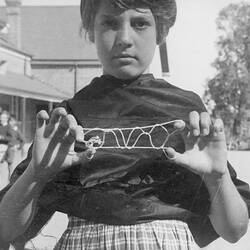Summary
Alternative Name(s): Hopscotch Markers, Shoe Polish, Pottery Sherd, Ceramic Fragment, Stone, Wood
Five assorted hopscotch taws, collected for the Children's Museum's 'You're IT!' exhibition held in Melbourne in 1988. A note with the acquisition refers to them as 'recreations', suggesting they were not actually used for hopscotch but are representative of what might have been used.
Hopscotch is played, with many variations, in countries all around the world. 'Scotch' is an old English word meaning to mark or score lightly, and drawing the playing grid in chalk, with a stone or with the toe of a shoe in the dirt, is generally the first stage of the game. Hopscotch diagrams have been found in the ruins of the Forum in Rome and in Pompeii. It is thought that hopping through the grid symbolised a journey - from life to death; from Heaven to Hell; or through the signs of the Zodiac. Hopscotch markers, or taws, are generally gathered from materials at hand and may be stones or rocks, empty tins filled with sand or broken crockery. These taws are typical of those used by children in Australian playgrounds and homes across generations.
Part of the Australian Children's Folklore Collection, unique in Australia, documenting contemporary children's folklore across Australia and in other countries reaching back to the 1870s. The Collection has a strong component of research material relating to Victoria.
Physical Description
Five assorted hopscotch taws, or markers, contained in a brown cardboard box with a lid. The box has been covered in clear contact adhesive and masking tape. The taws are: .1: Empty tin of shoe polish. .2: Square block of wood with heavy wood grain markings. .3: Flat piece of dark coloured stone. .4: White ceramic with a pattern of pink roses. .5: Heavy piece of white pottery with blue text and illustrations, c.1906.
More Information
-
Collection Names
-
Collecting Areas
-
Acquisition Information
Cultural Gifts Donation from Dr June Factor, 18 May 1999
-
Acknowledgement
Donated through the Australian Government's Cultural Gifts Program.
-
Date Made
-
Inscriptions
On tin: KIWI LIGHT TAN/NEW ADVANCED FORMULA/NET 40g On pottery: BROS/N.Z.Internat'l/Exh.1906-7.
-
Classification
-
Category
-
Discipline
-
Type of item
-
overall dimensions
15.5 cm (Length), 10.5 cm (Width), 6.3 cm (Height)
-
Exhibition Collection Management
118 mm (Length), 38 mm (Width), 9 mm (Height)
range of sizes, largest provided; group of 5
-
References
Grunfeld, F. 'Games of the World', pp164-7; Hope, C. 'Themes from the Playground', 1984, pp37-53; Sierra, J, 'Children's Traditional Games', p24.
-
Keywords
Children's Folklore, Children's Play, Games, Making Do, Recreation

